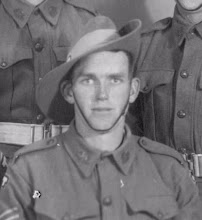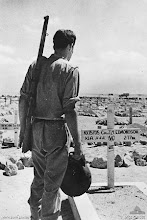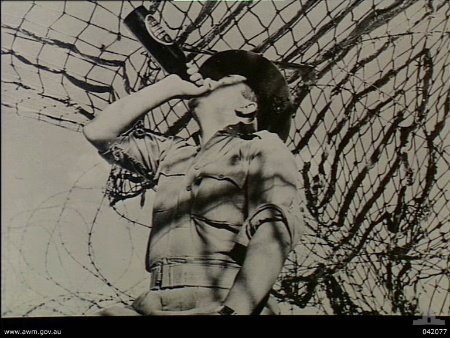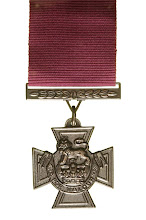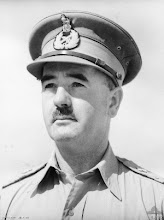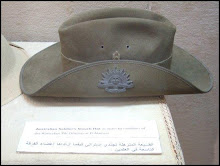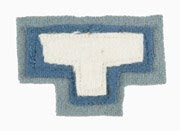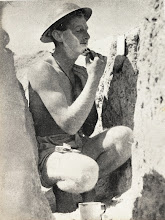
Tobruk, Libya, July 1941.
In the dug out of the Officers of the 2/24th Battalion.
This heavily sandbagged weapons pit in the Red Line of Tobruk is temporary home to VX48780 Capt. G.G. Anderson and VX48694 Capt. G.I "Ian" Malloch M.C. of the 2/24th Infantry Battalion.
This weapons pit appears roomier than other examples seen with ordinary ranks. That aside it is very much a functional structure. The highly sandbagged walls protected the men from shell burst, machine gun and sniper fire, provided that they kept their heads below the level of the sandbags. Note between the Captains is a rectangular firing slot in the sandbags to allow for weapons fire through the protective wall. German snipers were know to shoot men through these holes at ranges of 400 yards. A Lee-Enfield .303 rifle stands against the wall in the foreground. Both men wear the standard commonwealth Tin Hat, but this time with hessian covers.
VX48694 Capt. George Ian Malloch M.C. (right) was awarded the Military Cross for "conspicuous gallantry and devotion to duty" at Tobruk on 17th May 1941 for leading a counter attack on a heavily defended German position above an escarpment about 50 metres high. Despite being shot 5 times in the arm, head, knee, thigh and hand and incapacitated he kept his calm and successful ordered his men from his fallen position. This resulted in the position being taken and saved the lives of many men. Staying calm in spite of grievous injuries and keeping on task set an example amongst the men of the 2/24th that filled them with pride to serve with such an officer.
VX48780 Capt. Graham Grantham Anderson (left) died of wounds (D.O.W) received in the first Battle of El-Alamein on 13th July, 1942. At the time of his death he was 23 years old. Capt. Anderson is memorialised at the Australian Roll of Honour here:
The National Archives of Australia has a completely digitised version of VX48694 Capt. G.I Malloch M.C.'s service record. Included in this is the originally submitted citation recommending him for the Military Cross (page 28 of record). View Capt. Malloch's Service Record here:
(Enter Capt. Malloch's service number "VX48694" in the key word field, hit "enter", then click on the "View digital copy" link.)
image p00237.036 Australian War Memorial.








